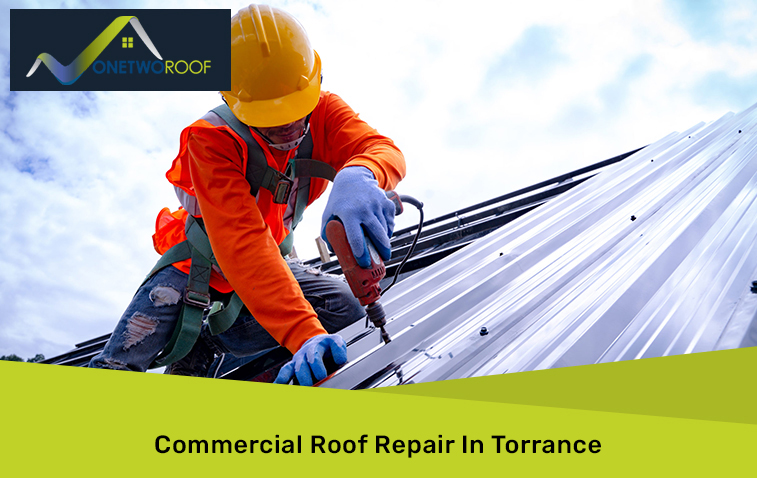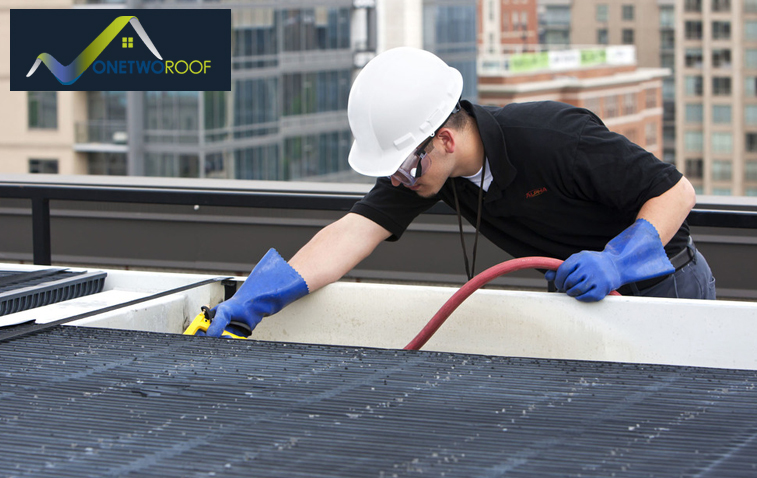commercial roof repair in Torrance
Getting commercial roof repair in Torrance isan essential service for businesses and organizations looking to maintain their roof at their best. Over time, various factors such as weather conditions, age, and improper maintenance can lead to common damages on commercial roofs, including leaks, cracks, blistering, and deterioration of materials. These damages, if left unaddressed, can result in structural issues, interior water damage, and increased energy costs.

Hiring a professional contractor skilled in commercial roof repair in Torrance is crucial in mitigating these problems. At One Two Roof, we help you to identify and repair damages efficiently, ensuring a watertight and secure roof that safeguards the assets and operations of commercial establishments.
The Right Time to Repair Your Commercial Roof
One of the most common reasons why people look for commercial roof repair in Torrance is that their roof is nearing the end of its lifespan. Here are some of the common roofing materials, that you can install along with their ages
| Roofing Material | Description | Average Lifespan |
|---|---|---|
| Built-Up Roofing | Multiple layers of asphalt or bitumen alternating with reinforcing materials such as fiberglass or felt | 15-30 years |
| Modified Bitumen | Asphalt-based sheets with added modifiers for enhanced durability and flexibility | 20-30 years |
| EPDM (Rubber) | Ethylene Propylene Diene Monomer, a synthetic rubber membrane that is heat and UV resistant | 20-30 years |
| TPO (Thermoplastic) | Thermoplastic Olefin, a single-ply roofing membrane with heat-welded seams | 15-30 years |
| PVC | Polyvinyl Chloride, a single-ply membrane known for its durability, chemical resistance, and energy efficiency | 20-30 years |
| Metal Roofing | Various metal materials like steel, aluminum, or copper formed into panels or sheets | 30-50+ years |
Fixing Leaks and Cracks on Your Commercial Roof
Fixing cracks and leaks is an important and common task for commercial roof repair in Torrance. You can contact us for any emergency repair. Here are the general steps in the process
Inspection
The work begins with a thorough inspection of the roof to identify cracks and leaks. We would look for areas where water may be pooling, seams, flashing, penetrations, and any visible damage. Notes will be taken or mark the locations requiring repair.
Clean the Roof
All debris, dirt, or loose materials will be removed from the affected area. A broom or brush will be used to sweep away loose particles. A clean surface will allow for better adhesion and help identify the extent of the damage more accurately.
Prepare the Surface
Depending on the roofing material, you may need to prepare the surface before applying any repairs. For example, if you have a single-ply membrane roof, clean the area thoroughly and use a recommended cleaner or primer to promote adhesion
Patch Cracks
For smaller cracks, a roofing sealant will be used that is appropriate for your roofing material. The sealant will be applied generously over the crack, extending it a few inches beyond the damaged area. Then, it will be smoothed out using a putty knife or trowel, ensuring a watertight seal. We will follow the manufacturer’s instructions for curing time and application.
Fix Leaks
If we have identified a specific source of leakage, such as around a vent or chimney, we will focus on addressing those areas. The damaged flashing will be replaced or the gaps will be sealed with appropriate materials. We will apply sealant or roofing cement generously, ensuring complete coverage
Regular Maintenance
Once the repairs are completed, establish a routine maintenance schedule for your commercial roof. Regular inspections, cleaning, and proactive repairs can help prevent future problems and extend the lifespan of your roof.
The Cost of Commercial Roof Repair in Torrance
The cost of commercial roof repair in Torrance can vary depending on several factors. Here are some key factors that can influence the cost

Roof Size
The size of the commercial roof is a significant factor in determining the repair cost. Larger roofs will generally require more materials and labor, resulting in higher costs.
Roofing Material
The type of roofing material used on the commercial roof affects the repair cost. Different materials have varying prices and installation requirements. For example, repairing a flat roof with built-up roofing (BUR) will have different costs compared to repairing a metal roof or a single-ply membrane roof.
Extent of Damage
The severity and extent of the damage will impact the repair cost. Minor repairs, such as fixing a few leaks or replacing a few damaged shingles, will generally be less expensive compared to extensive damage requiring significant repairs or replacement of large sections of the roof.
Accessibility
The accessibility of the roof can influence the cost. If the roof is easily accessible and the repair work can be done with minimal effort, it may be less expensive. However, if the roof is difficult to access, such as in high-rise buildings or roofs with limited entry points, it may require specialized equipment or additional safety measures, increasing the cost
Roof Age
The age of the roof can affect the cost of repairs. Older roofs may require more extensive repairs due to wear and tear or outdated materials, which can increase the overall cost.
Additional Features
Commercial roofs may have additional features that can impact the repair cost. This includes the presence of skylights, vents, HVAC units, or other equipment installed on the roof. Repairing or working around these features may require extra time and effort, contributing to higher costs.
Local Factors
The cost of labor, materials, and permits can vary depending on the location. Factors such as local building codes, labor rates, and availability of roofing contractors can influence the overall repair cost.
